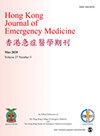An eLearning program to prepare residents for a rotation in pediatric emergency medicine: A qualitative study
IF 0.8
4区 医学
Q4 EMERGENCY MEDICINE
引用次数: 1
Abstract
Background: To meet ACGME-I (Accreditation Council for Graduate Medical Education–International) training and duty hour requirements, we converted our 3-week-long pediatric emergency medicine induction program to an eLearning program. Objectives: The study aimed to identify areas of the eLearning program residents perceived useful and the components that helped them prepare for clinical work. Methods: The qualitative study took place in a tertiary pediatric emergency department. Twenty-seven residents from family medicine, emergency medicine, and pediatric medicine participated in focus group discussions to explore how they perceived the eLearning program helped prepare them for work. The interviews were audio-recorded, and transcripts were analyzed and coded into categories and themes. Results: Four themes emerged from the data analysis: residents’ access to the eLearning program, instructional methods, eLearning design elements, and supplementary learning. Residents valued autonomy to control their pace of learning and use online features that matched their preferred learning styles. Design features such as the use of questions and quizzes helped stimulate learning, but attention had to be paid to the order of questions in the modules and the format of the questions. Written guidelines served as a good reference for learners and face-to-face sessions accompanying the eLearning program helped reinforce knowledge and offered opportunities to interact with faculty members to clarify questions. Conclusion: Systematic planning focusing on access, instructional methods, and design is essential when creating eLearning programs for residency training. eLearning programs can be enhanced by the incorporation of team-based learning and having accompanying written content to reference.一项为住院医师准备儿科急诊医学轮换的电子学习计划:一项定性研究
背景:为了满足ACGME-I(国际研究生医学教育认证委员会)的培训和值班时间要求,我们将为期三周的儿科急诊医学入门课程转换为电子学习课程。目的:该研究旨在确定住院医生认为有用的电子学习计划领域以及帮助他们为临床工作做好准备的组成部分。方法:定性研究在一家三级儿科急诊科进行。来自家庭医学、急诊医学和儿科医学的27名住院医生参加了焦点小组讨论,探讨他们如何看待电子学习计划帮助他们为工作做好准备。对访谈进行录音,并对笔录进行分析,并按类别和主题进行编码。结果:从数据分析中得出四个主题:居民对电子学习计划的访问,教学方法,电子学习设计元素和补充学习。居民重视自主控制他们的学习速度,并使用与他们喜欢的学习方式相匹配的在线功能。问题和测验的使用等设计特点有助于刺激学习,但必须注意模块中问题的顺序和问题的格式。书面指导方针为学习者提供了很好的参考,在线学习项目附带的面对面会议有助于巩固知识,并提供了与教师互动以澄清问题的机会。结论:在为住院医师培训创建电子学习课程时,关注访问、教学方法和设计的系统规划是必不可少的。电子学习计划可以通过结合团队学习和附带的书面内容来增强。
本文章由计算机程序翻译,如有差异,请以英文原文为准。
求助全文
约1分钟内获得全文
求助全文
来源期刊

Hong Kong Journal of Emergency Medicine
EMERGENCY MEDICINE-
CiteScore
1.50
自引率
16.70%
发文量
26
审稿时长
6-12 weeks
期刊介绍:
The Hong Kong Journal of Emergency Medicine is a peer-reviewed, open access journal which focusses on all aspects of clinical practice and emergency medicine research in the hospital and pre-hospital setting.
 求助内容:
求助内容: 应助结果提醒方式:
应助结果提醒方式:


